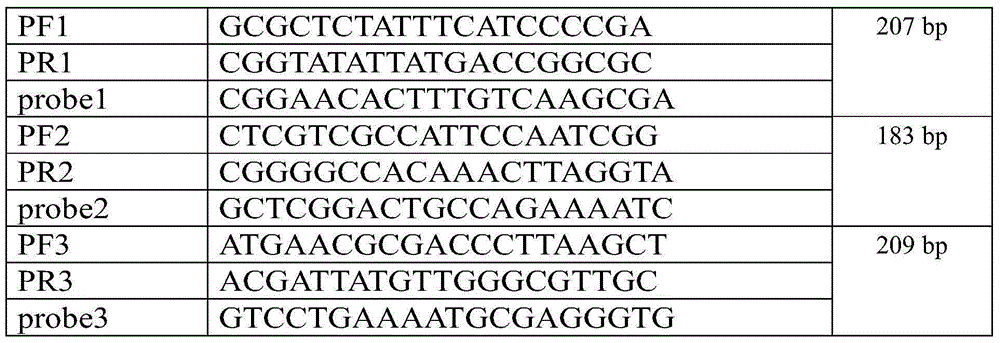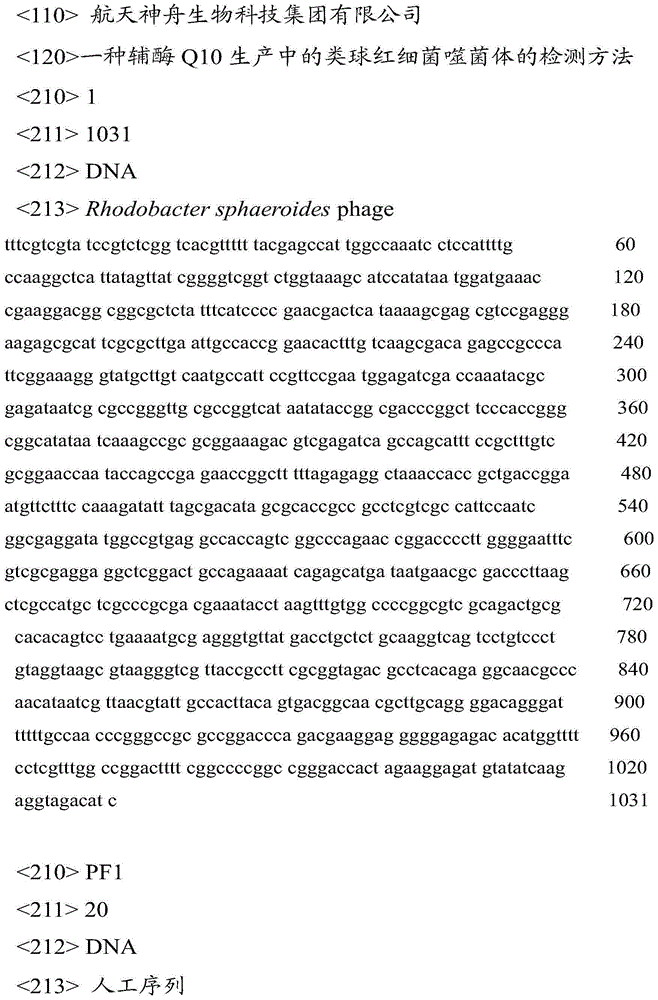Detection method of rhodobacter sphaeroides phage in coenzyme Q10 production
A technology for the detection of Rhodobacter sphaeroides and a detection method, which is applied in the field of rapid detection of phages of Rhodobacter sphaeroides, which can solve problems such as lack of guidance for production, and achieve the effects of avoiding phage contamination events, simple methods, fast and accurate phage detection
- Summary
- Abstract
- Description
- Claims
- Application Information
AI Technical Summary
Problems solved by technology
Method used
Image
Examples
Embodiment 1
[0061] Artificially synthesize the target fragment according to SEQIDNo.1;
[0062] The target fragment is amplified by PCR with primers PF and PR, and the target fragment is recovered after amplification, wherein,
[0063] PF: TTTCGTCGTATCCGTCTCGGT;
[0064] PR: GATGTCTACCTCTTGATATAC;
[0065] Recovered target fragments, connect the recovered target fragments to the T vector, transform into E.coliDH5α competent cells, pick positive clones for enrichment culture, and extract plasmids after amplification. cut linearization, and the starting template was obtained after purification;
[0066] Dilute the starting template, starting templates with different copy numbers, the range is: 1.0×10 2 Copy - 1.0×10 6 Copy and divide equally by 10 times;
[0067] Using PremixExTaq from TaKaRa TM II Quantitative PCR kit recommended steps for PCR, specifically:
[0068] The PCR reaction system is 20 μl: Taq enzyme solution 10 μl, PF1 and PR1 primers 0.8 μl (10 pmol / μl), probe1 probe 0....
Embodiment 2
[0075] Artificially synthesize the target fragment according to SEQIDNo.1;
[0076] The target fragment is amplified by PCR with primers PF and PR, and the target fragment is recovered after amplification, wherein,
[0077] PF: TTTCGTCGTATCCGTCTCGGT;
[0078] PR: GATGTCTACCTCTTGATATAC;
[0079] Recovered target fragments, connect the recovered target fragments to the T vector, transform into E.coliDH5α competent cells, pick positive clones for enrichment culture, and extract plasmids after amplification. cut linearization, and the starting template was obtained after purification;
[0080] Dilute the starting template, starting templates with different copy numbers, the range is: 1.0×10 2 Copy - 1.0×10 6 Copy and divide equally by 10 times;
[0081] Using PremixExTaq from TaKaRa TM II Quantitative PCR kit recommended steps for PCR, specifically:
[0082] The PCR reaction system is 20 μl: Taq enzyme solution 10 μl, PF1 and PR1 primers 0.8 μl (10 pmol / μl), probe1 probe 0....
Embodiment 3
[0089] Artificially synthesize the target fragment according to SEQIDNo.1;
[0090] The target fragment is amplified by PCR with primers PF and PR, and the target fragment is recovered after amplification, wherein,
[0091] PF: TTTCGTCGTATCCGTCTCGGT;
[0092] PR: GATGTCTACCTCTTGATATAC;
[0093] Recovered target fragments, connect the recovered target fragments to the T vector, transform into E.coliDH5α competent cells, pick positive clones for enrichment culture, and extract plasmids after amplification. cut linearization, and the starting template was obtained after purification;
[0094] Dilute the starting template, starting templates with different copy numbers, the range is: 1.0×10 2 Copy - 1.0×10 6 Copy and divide equally by 10 times;
[0095] Using PremixExTaq from TaKaRa TM II Quantitative PCR kit recommended steps for PCR, specifically:
[0096] The PCR reaction system is 20 μl: Taq enzyme solution 10 μl, PF2 and PR2 primers 0.8 μl (10 pmol / μl), probe2 probe 0....
PUM
 Login to View More
Login to View More Abstract
Description
Claims
Application Information
 Login to View More
Login to View More - R&D Engineer
- R&D Manager
- IP Professional
- Industry Leading Data Capabilities
- Powerful AI technology
- Patent DNA Extraction
Browse by: Latest US Patents, China's latest patents, Technical Efficacy Thesaurus, Application Domain, Technology Topic, Popular Technical Reports.
© 2024 PatSnap. All rights reserved.Legal|Privacy policy|Modern Slavery Act Transparency Statement|Sitemap|About US| Contact US: help@patsnap.com










